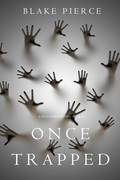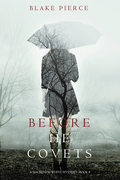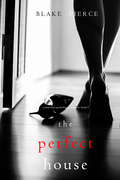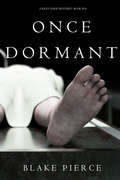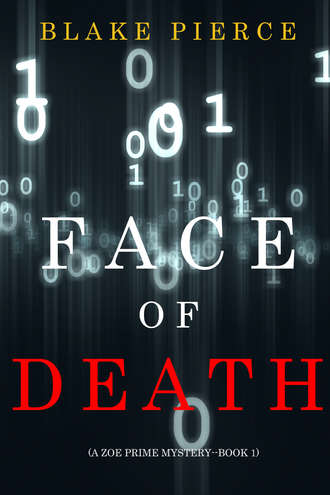
Блейк Пирс
Face of Death
Not only that, but something else kept catching at her mind. The Rorschach of the blood pools. The patterns. Why had that tugged at something in her mind, something that gave her a certainty that it was his work? If she could just figure out what it was that had linked that mental image with the other kill sites, she would have him.
The uncomfortable thought began to stir that maybe he, like her, could read the numbers. That maybe this was the work of someone with the devil’s ability to see things no one else could.
Find the pattern, find the killer, Zoe told herself. And find him now—before he kills again.
CHAPTER FIFTEEN
Zoe sat at the side of one of the desks, getting a bird’s-eye view of the investigation room. It was alive again, full of activity and of new sheets of paper joining the piles spread across the desks. There were so many files, now laid open to be read at a glance, something in them ready to give up their secrets if only she could look closely enough. The numbers she had already seen flashed before her eyes, just a distraction. They were not what mattered. It was the numbers Zoe had missed until now that she needed.
Zoe scanned over the reports in front of her, knowing that there was something here. Something they had all missed. If she could only get her teeth into it—
“We have a match for the tires,” Shelley said, putting down the phone with a clatter as she spun her wheeled desk chair over to towards Zoe. “Sedan. Probably an older model, they think, judging by the width. The tread was fairly well-worn, so he’s been on the road a bit. There’s a few different manufacturers with sedans that use those tires, but it’s a start.”
Zoe nodded, pulling a sheet of paper from the fax machine. It baffled her that, in this day and age, the sheriff’s team was still using a fax machine, but it was not for her to tell them how to renovate their office. “This is from the coroner. It is a photograph… what is that?”
She tilted her head, analyzing the image. A splotch of green color on a white background. There was a standard rule to one side, indicating that it was less than a centimeter in both width and length. Other than that, the coroner had sent no information.
“Let me see?” Shelley held out her hand, and tilted her own head in a similar way. “Oh! It’s a paint chip. I think. Let me call him and check.”
Zoe ignored Shelley’s call, filtering out her voice in the background. Paint chips and sedan models were good news for the investigation in general, but there was something else here. Something nagging at the back of her mind that she just hadn’t quite figured out yet. Whatever it was, it could save the life of another woman—because the killer had not stopped or slowed down, and his pattern demanded another body tonight.
“It’s a paint chip,” Shelley confirmed, rolling back over. “The coroner says it was underneath one of her fingernails. Chances are good that it came from the killer’s car.”
Zoe tore her attention from the case files and got up, heading to their easel pad. “New profile, then,” she said. “We are searching for an older model green sedan with out-of-state plates, driven by a male fitting the physical description we already worked up.”
Shelley’s face almost glowed with enthusiasm. “We’re narrowing it down.”
“It is still a wide net to cast,” Zoe said thoughtfully, tapping the board pen against her lower lip. What wasn’t she seeing here? “We should put out an APB on this description.”
“On it!” Shelley jumped out of her seat and almost ran from the room, heading for the sheriff’s office and his controls.
Her eagerness might have been annoying or off-putting, except for the fact that she was getting things done. Zoe had to admit to herself that she was happy to have another pair of hands and eyes on this. There were too many working parts, too many pieces of the puzzle missing, to do this by herself.
They were still heavily lacking in physical evidence, however. Identifying the car was one thing, and they had not truly been able to do that. There were still probably hundreds, if not thousands, of vehicles matching the description they had. Going through databases and tracking each of them down was not an option. By the time they had worked through the list, there would be bodies piled up in every state across the whole country.
Except that he wasn’t targeting the whole country, was he? He was moving in a curve—a curve that only Zoe could figure out how to track. The numbers couldn’t let her down, not this close to some kind of clue. She just had to keep looking.
Zoe glanced over crime scene photographs from each of the women, glazed eyes and open throats staring back at her. She could read all kinds of numbers in the frames. A twelve-inch skirt against an outfit that hovered only an inch above the ground. A 34D bust, a 40F, a 32B. Seventeen dollars stuffed into a phone case for safety that had not been taken. They told her something about the victims, but nothing at all about the killer.
In her bones, Zoe knew that they were right about his choice of victims. That it was the locations and the opportunity that mattered, not getting the exact right person into his grasp. She needed to stop looking at the women, as hard as that was when a blood-soaked body rested gray in full-frame under camera flash. She needed to look beyond them, at the place. The scene.
What wasn’t she seeing?
Zoe began again, working through the photographs of the gas station. Frustratingly few of the images contained anything other than the body itself. In the background, she could catch the price of gas reflected in the windows, the three varieties of local newspapers on sale, count the yards between the victim and the front door. But there was nothing, nothing that told her who the killer was.
Something tugged at her memory, and Zoe frowned, shuffling through the photographs again. There was only one shot that contained a single, blue-colored piece of candy. But that wasn’t right, was it? There had been more candy—much more. She remembered the colors scattered around her as she walked the scene.
She got up and walked down the corridor, to the small room down the hall where the local police photographer had set up his equipment. He was sitting in front of a large-screened Mac, the most modern piece of equipment in the whole place, and jumped when she thrust open the door without knocking.
“Can I help you, ma’am?” he asked nervously.
“The gas station crime scene,” Zoe said, cutting to the chase. She did not appreciate it when other people delayed matters with small talk, and given that no one else appeared to enjoy it either, she wasn’t sure why it was usually insisted upon. “Do you have any photographs of the candy that was scattered across the parking lot?”
The photographer stood, making his way to a filing cabinet at the side of the room and drawing out a slim plastic folder. He started to flip through printouts, each of them encased in a shiny plastic pouch for protection, until he found what he was looking for.
“Here,” he said. “I grabbed one shot. I thought it was kind of whimsical, candy at a murder scene. Didn’t seem to be any forensic value in it, though. Sheriff said it was probably dropped by a kid.”
Zoe took the folder from his hands, studying the image closely. “Thank you,” she said, turning to go back into the corridor.
“Those aren’t really supposed to leave my room,” the photographer said, but failed to follow up when she ignored him and continued walking.
Small-town protocol or not, there was something here. She could sense it. And if it was going to save someone’s life, then she didn’t give a damn about which room the folder was supposed to stay in.
Just one photograph. That underlined, more than anything else, the fact that no one else could see what she could see. Because this was it. She could feel it. This was something that they had all overlooked, but it was the key to the whole case.
Zoe sank back into her chair, her eyes running over and over the collection of candy on the floor. With this shot, taken from directly above and some distance up—perhaps on a step-ladder—she could see the pattern as it really looked. Because it was a pattern—just like everything else.
Most other people would have looked at that and seen a random scattering of candy. Something dropped by a child, maybe. Meaningless. But if there was one thing that Zoe had learned over time, it was that nothing was ever meaningless. The hardy shrubs of Arizona grew a certain distance apart based on whatever nutrients they could find. Clouds formed on air currents, following pressure lines and forced by temperature and humidity. People moved in the same patterns day after day, life after life, driven by pre-ordained social assumptions and genetics.
And the candy had fallen into near-perfect vertices of a convex polyhedron. All you had to do was connect the dots to see the straight lines drawn between each one. They were plain to see, once you knew how to look.
Almost anyone would have dismissed this as random trash, something to be cleared up and thrown away. But he hadn’t. He had cleaned away everything else, the footprints, any traces of his presence. But he had left those dropped pieces of candy behind, scrupulously avoiding them, letting them stay where they fell.
There was a moment of doubt in her mind, but in truth it was not doubt that she was wrong. She knew she had to be right. The doubt came from fear, fear that she had something in common with a brutal killer. A serial killer—one who treated human lives like pieces of scattered candy. Something disposable, used only for the creation of a pattern.
A fear that she could turn out to be the same. The devil was in her, her mother had said.
Zoe knew she wasn’t an evil killer—even if she had difficulty connecting with other people, she still saw them as humans. The fear came from outside herself, from her mother’s superstitions and the need to hide who she really was.
But fear or no fear, she could not deny what she was seeing in front of her. All of the pieces clicked into place, a complete picture now, and though they might be rearranged she could not imagine them telling any other story.
Now Zoe knew who their killer was. He was like her. He saw things the way that she did. He looked at those scattered pieces of candy and saw a divine signal that he was on the right track. He looked at the Rorschach pattern of wings left by a neck wound and it encouraged him to go on.
He wasn’t just making a random curve driven by necessity. He was forming a pattern.
And now that she knew him, she could catch him. She could make him stop.
The only question was whether she could do it before he took another life.
***
Zoe came back to herself, realizing that she had been staring off into the distance, thinking for quite some time. She was seeing everything from a new perspective. Everything had changed. He thought the same way that she thought—and Zoe knew how she thought better than anyone else.
Shelley had come back into the room to sit quietly looking through the files, but Zoe barely noticed that she was there. She was too focused, and her mind was swirling.
Zoe grabbed and hastily assembled each of the victim files in order, taking both the crime scene notes, the coroners’ reports for all but the latest body, and the photograph that best showed the full scene. Seeing them all side by side like this, it was clearer than ever that there was a connection. The gaping second mouths across the throats, all the same width and depth to within a millimeter, the pressure applied to precisely the same degree each time.
All the work of the same two hands. Hands that even now were clasping a steering wheel, driving him to the destination where he would meet his next victim. Zoe eyed the map on the wall, took in the curve. Saw the towns that were potentially in its path. She focused in on a particular area, the zone where the curve was likely to continue—a rural town, just a few buildings, a waypoint on the road.
No one was going to die there tonight. Not if she could do anything about it.
A deputy came and knocked on the door of the investigation room, hesitating with a brown paper bag in his hand.
“Come in,” Shelley said, offering him a smile. “Is that lunch?”
“The sheriff said I should bring you something,” he said, pausing again before stepping into the room, as if crossing a forbidden line. “I didn’t know what you liked, so I got a few different sandwiches. And some pastries, too.”
“That’s very kind.” Shelley smiled, taking the bag from him.
“Is it lunchtime?” Zoe asked, looking up at the old-fashioned clock mounted on the wall. Time was running away from them. She could count the number of hours before he would attempt to kill again on one hand. Certainly before midnight, there would be another body—unless she could find him first.
Zoe thanked the deputy and reached indiscriminately for a sandwich, not caring which one she lifted out. It turned out to be grilled cheese and tomato, a fact which she barely registered except to note the half-inch thickness of the bread, the fact that the slices comprised only two-thirds of a tomato, and the uneven flare of butter along each side of the interior. Whatever it was, to a brain which needed fuel, it was delicious.
The files in front of her took her attention, the numbers even clearer now than they were before. She saw at a glance their heights, their ages, the salary they earned each year, the year in which they graduated from high school (or failed to do so), the number of dependents they had, the length of their hair in millimeters. None of it provided any kind of link or pattern.
Zoe was coming up short, but it was not necessarily a bad thing. This was a sign that she was on the right track. Ruling out a link between the victims meant that her instinct was correct, and the location was the thing. She was now more sure of that than ever. The extra twenty minutes to be certain was worth it—and the evidence was in the last victim, the young woman they had identified as Rubie.
Why would the killer be so angry with the woman who ran from him that he would kick her, even after death? It didn’t make sense—not if you couldn’t see the way he thought. If you looked at it from the perspective of any other person, you might say that he was just frustrated, or dumb, or petty enough to delight in kicking a dead body. None of which was borne out by the other crime scenes.
Zoe put herself in his shoes. If she was the killer, what would she be so angry about? What on earth would make her feel mad about getting her way?
Unless, of course, she hadn’t entirely gotten her way.
That had to be it. And just like that, Zoe knew.
The answer was a simple one. Not because she had fought back—they all had, to some degree that they were able, even if it was just to flail around and gasp for air. It was not simply because she had run from him, or fear that she would not die—because she had died, by the time he found her in the woods.
No, it was because she had ruined his pattern. Zoe could see that now, as clear as the bright sunlight streaming in through the windows in the hall outside, casting a square of glowing yellow on the far wall that encapsulated their easel board and made it almost impossible to read the profile written on it.
Zoe didn’t need the profile anymore. She knew what she was looking at now.
A man who lived for the patterns, lived and died by them. Or rather, killed by them. The pattern was important to him above anything. Which meant that the curve on the map was not just a curve—it was a message.
A message that Zoe was now determined to understand.
The phone on the wall burst into a shrill ring, scattering her thoughts. Shelley got up to answer it without being asked, which was another reason why Zoe was beginning to like her very much.
“Really?”
Something in Shelley’s tone, the sharpness of it, made Zoe look up and pay attention.
“When was this? … And you’ve just flagged up the match in the system now? Right, yes. If you could fax everything over as soon as possible. Thank you.”
She put the phone back into the wall holder, then turned to Zoe with wide eyes. “There’s another one. Five days ago, but the local PD only just put the data into the system and saw the match with our cases. Looks like it might have been his first kill.”
Zoe shot out of her seat, heading to the map pinned up on the wall. “Where?”
There was only one question that mattered now. The who was irrelevant. The how was obvious—murder by garrote, otherwise it would never have flagged up as a match. The why was becoming clearer at every step they took.
It was the where that could unlock the whole thing.
Shelley ran to the fax machine, grabbing out the first piece of paper it was hastily spewing. She scanned the page hastily, shouting out a town name as soon as she found it.
Zoe scanned the map, looking for something along the straight line or even the gentle curve that she now knew it was. Where was this town? She searched names again and again, not seeing it, wondering where it could possibly be.
She stepped back, gesturing for the piece of paper, taking it from Shelley’s hands and examining it herself. The name of the place was right. So then, why wasn’t it where it was supposed to be?
Zoe looked up, and by chance her eyes dragged over another part of the map as she oriented herself, and the name jumped out at her. There. But not at all where she had expected it to be. It was way off to the side, far above the latest pin. Zoe pushed the new marker into the wall and then stood back again, taking it all in.
And, oh, how stupid she felt at that moment, now with all of the clues in her possession.
What she had at first mistaken for a straight line with clumsy deviations, and then for a curve, was in fact neither of those things. The turn was too steep to be accurately described as a curve. It was a shape instead, a shape that had yet to be completed.
But it was too steep, again, for it to be a circle. If the data points ever did meet in a closed loop, it would have been squished and off-centered, a strange misshapen thing. The pattern mattered far too much to the killer for him to make that kind of mistake. No, it was not a circle.
It was a spiral—or it was going to be, once he finished it.
A little squished, a little strained, but a spiral.
How could she have missed this for so long? Rubie wouldn’t have needed to die if Zoe had worked out that the next point would be somewhere along that highway. They could have stationed cars and dogs and helicopters. They could have caught him, even if his spiral was too deviant from a truly composed shape to be completely accurate with her estimations.
But did that fit with what she was thinking? If he was focused on the pattern, would he really allow it to be so imperfect? That didn’t seem to sit right with Zoe.
The victims didn’t matter, and they never had. Their killer was just picking someone in the right place at the right time—for his purposes, at least—and making them into a pin on a map. If the victims didn’t matter, and the killer was so angry at his latest victim for running, then—
Zoe took the pin out of the woods, where the body had been found, and moved it back to the very entrance of the access road. The point where he had actually attacked.
“Shelley, was the victim found dead in the place where the attack happened?” she asked, urgency in her voice.
Shelley flipped through the other pages that the fax machine was still spitting out, frowning. “Hold on, let me… Um… No, it doesn’t seem like it. The man was found outside a farmhouse—wait, man? That breaks the pattern.”
“No, it doesn’t,” Zoe said impatiently. “Come on. Where was he attacked?”
“On the grounds of the farm.” Shelley stepped forward, placing her finger on the map. “Here. It looks like he ran.”
Zoe moved the red pin, just a small degree. But when she had done that, the spiral was neater, more composed, more aligned with what she might have expected. It turned out that they had been looking at it wrong from the very beginning. It was not the sites where bodies were recovered that mattered. It was where the attacks took place—the specific and precise locations where the killer wanted them to be.
The phone rang again, somewhere distantly at the range of Zoe’s attention. She ignored it, letting Shelley take care of it. That was not important right now. What was important was the pattern.
He had not waited for the gas station attendant to round a corner because he wanted to distract her, or give her false hope, or because it was all a game. It had been there because it had to be there, otherwise his spiral would not work.
In fact, looking at it now, Zoe would call it a perfect spiral. Nothing was a mistake, and there was no deviation. This was a perfect spiral of the kind that was seen everywhere in nature, a Fibonacci spiral, the spacing decreasing in precise ratios until it reached an end point.
That meant two things. The first was heartening: it was that there was going to be an end to the murders.
The second was less so.
It was that there were three more murders to come before the spiral was complete.



